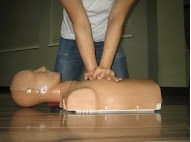
CPR is an integral part of first aid training so many centres will often provide both first aid and CPR training concurrently so that the trainee gets the most of the sessions at hand. Over the years, CPR techniques have continued to improve significantly, and this has led to numerous amendments made in light of better procedures. One of the most significant changes made in the industry involved the elimination of mouth-to-mouth when offering CPR, leading to a technique known as hands-only CPR. Ideally, the inclusion of mouth-to-mouth CPR was facilitated to allow the first aider to breathe on behalf of the patient.
In years gone by, the mantra was to carry out 15 chest compressions accompanied by 2 rescue breaths. Fast forward to 2010, and this underwent amendments so that today, providing rescue breaths is not an integral part of the CPR procedure. This was done following extensive research carried out by the ILCOR – the International Liaison Committee on Resuscitation- which showed that even for professional medics, it was not always necessary to get rescue breaths underway. This science is currently been promoted with vivacity to make sure that first aiders are well informed on the procedures to follow at the time of administering first aid.
To gain more insight into these techniques, it becomes critical to make sure that one has a proper understanding of how the body works in line with the circulatory system. Typically, the sole function of the heart is to pump blood to the rest of the body in order to deliver both nutrients and oxygen are required by the tissues. It is interesting to note that since a number of the organs in the body can be transplanted save for the brain, in essence, all the heart does is to keep the brain active and alive. When the heart pumps blood, this creates pressure that is aptly measured in mmHG. In the event that a patient stops breathing and/or their heart stops beating, the need for compressions arises for one simple reason: to ensure that circulation is maintained by creating artificial pressure on the heart. This way, blood is forced out of the heart and into circulation where it is sent to the rest of the body.
Studies have shown that it takes at least 10 continuous chest compressions in order to keep blood flowing to the brain. When the compressions come to a halt, the pressure plummets to 0. This is the reason why compressions play a fundamental role in CPR, and is in fact one of the major reasons why the order of carrying out resuscitation was changed from A-B-C to C-A-B where A is for checking Airway, B- for Breathing and C for circulation. By offering compressions first, a first aider is able to save precious seconds that could mark the very difference between life and death. With the knowledge that rescue breaths are not essential, this form of CPR should be able to increase the chances of a victim’s survival.
